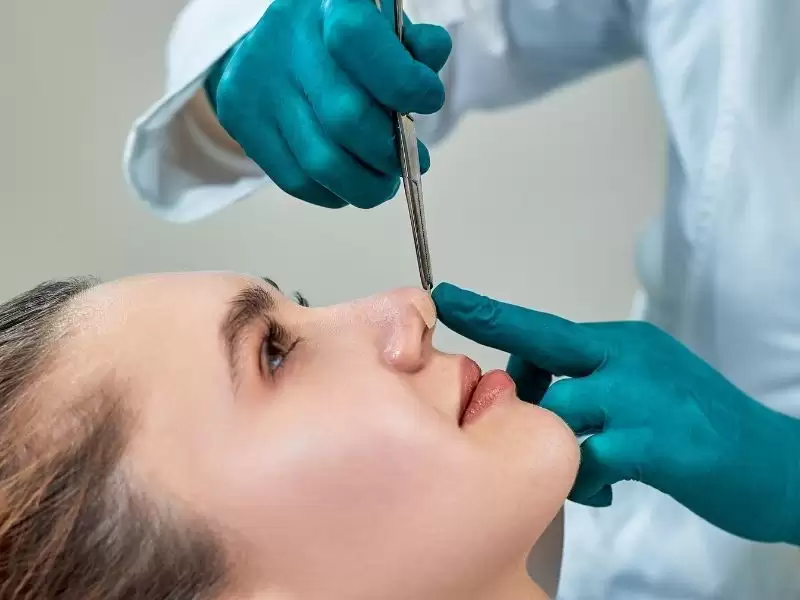As years pass, the cheeks begin to sag, the lower eyelids lengthen, the folds starting from the sides of the nose deepen, the jawline loses its definition, and the corners of the mouth turn downward, creating creases. Thanks to facelift surgery and thread lift techniques, it is possible to correct the changes that occur in the aging face. A younger and more vibrant face dramatically improves the patient’s external appearance and self-perception. The goal here is to achieve a natural and aesthetic appearance. The main aim is to obtain a rejuvenated face that does not look artificial and retains the person’s true identity. As the face tends to take on a square shape with aging, the facelift procedure redefines the contours into an upward-facing triangle, restoring a youthful and harmonious appearance.
Facial aging, which is examined in the upper, middle, and lower face regions, is treated through a modified procedure that combines various existing techniques with methods we have developed ourselves. The main goal here is to reposition each tissue area to where it naturally belongs. The procedure is not limited to a simple lifting process; instead, harmony between surrounding areas is considered to achieve overall facial balance. The surgical incisions are carefully hidden within the areas in front of and behind the ear to ensure they remain concealed.

The thickness of facial tissues plays a very important role in this procedure. In patients with thick, fatty cheeks, since tissue volume is sufficient, some additional techniques need to be applied to achieve longer-lasting results. For those with excess fat tissue, liposuction is performed to contour the area. In patients with thinner tissue, on the other hand, certain techniques to increase tissue volume may be required.
The most feared complication — facial paralysis due to facial nerve injury — is now extremely rare thanks to modern anatomical studies and advanced surgical techniques. In experienced hands, it can be said that it almost never occurs.
The duration of the surgery varies between 1 and 4 hours, depending on the procedure performed. It can be done under local or general anesthesia. After the surgery, the patient may go home if desired.
Facelift Surgery
The face is the area of the human body that is most frequently exposed to air and constant sunlight. For this reason, the facial skin gradually loses its elasticity over time and develops certain deformities. When cosmetic skincare products or non-surgical facial aesthetic procedures are not sufficient to correct these imperfections, facelift surgery becomes a preferred solution. Facelift surgery is a highly effective method for addressing wrinkles and sagging along the jawline and neck area.
It is important to consider the face as a complete aesthetic unit. Procedures performed on only one part of the face can lead to imbalances or distortions in other areas. Therefore, for women who most commonly prefer this operation, the planning of facelift surgery must be carried out with precision and attention to overall facial harmony.
When Is a Facelift Necessary?
Facelift surgery can be performed on individuals who experience facial sagging due to genetic factors, aging, or significant weight fluctuations. In some people, certain skin types tend to deform more rapidly and cannot be effectively treated with non-surgical methods. For such individuals, facelift surgery becomes a suitable and effective option.
Before Facelift Surgery
Due to aging, poor nutrition, or environmental factors, the skin structure—especially in women—can deteriorate over time. The lower face, jawline, and under-chin areas are particularly prone to sagging and volume loss. In cases of advanced sagging, facelift surgery is often the most effective treatment to restore firmness and rejuvenate the facial appearance.
Before facelift surgery, choosing the right surgeon with great care is extremely important. During the preoperative planning stage, the patient should clearly communicate their expectations to the doctor. The effectiveness and recovery period of facelift surgery vary depending on the individual and their skin type. Generally, noticeable positive results begin to appear about one month after the procedure.
Facelift surgery typically lasts between 2 and 3 hours and is performed under general anesthesia. It should be remembered that facelift surgery is not a wrinkle treatment but a solution specifically aimed at correcting sagging problems. For mild wrinkles, non-surgical methods such as fillers and Botox can be more suitable alternatives.
After Facelift Surgery
When performed by experienced surgeons, facelift surgery is carried out in a way that minimizes the appearance of scars. Moreover, since the incision marks are hidden within the hairline, they are not noticeable after recovery. Applying cold compresses after the surgery helps support the healing process. During the postoperative recovery period, the facial area should be carefully protected from any harsh contact or pressure to ensure proper healing and optimal results.
What Are the Risks of Facelift Surgery?
The main risks of facelift surgery include bleeding, infection, hair loss, nerve damage, and the possibility of visible or cosmetically unsatisfactory scars. However, these risks can largely be minimized through careful surgeon selection and proper postoperative care.
Non-Surgical Facelift
With the advancement of modern technology, significant progress has been made in both medicine and aesthetics, leading to the development of new diagnostic and treatment methods. Non-surgical facelift procedures have become increasingly popular in recent years. Although their effects are not as long-lasting as surgical options, they can be safely repeated when needed, offering patients a convenient way to achieve a rejuvenated appearance without surgery.
Click here to learn more about Neck Lift in Ankara.
Frequently Asked Questions About Facelift
Can a facelift surgery be repeated?
Facelift surgery does not stop time. After the procedure, the patient continues to age naturally. However, if a facelift is performed at an early age, a second surgery can be done 10–15 years later. Alternatively, supportive facial rejuvenation methods can be used to delay or extend this period. If the initial facelift was performed conservatively, more extensive lifting can be achieved in subsequent operations.
What complications can occur during facelift surgery?
As with any surgery, facelift procedures carry certain risks. These may include early wound healing problems, infection, bleeding, and issues with skin circulation. Rarely, facial nerve damage, salivary gland leakage, unsatisfactory results, or differences between the expected and perceived appearance may occur.
When can one return to work after facelift surgery?
The timing of return to work depends on the nature of the job. After facelift surgery, patients are advised to wear a facial and neck corset for one week. With this corset, office workers can usually resume light work within a few days. Swelling typically subsides within the first week, after which the corset is removed. Most patients return to normal social and professional activities around this time, though healing speed and swelling vary from person to person.
What conditions should be reported to the doctor before facelift surgery?
If there are any signs of infection in the body, this must be reported to the doctor. Otherwise, infection can spread to the surgical area through the bloodstream after the operation. All medications should be disclosed, as drugs like aspirin may increase bleeding, while steroids and antineoplastic drugs can delay wound healing. Excessive smoking and alcohol consumption should also be communicated to the doctor.
What precautions should be taken before facelift surgery?
Blood-thinning medications and herbal supplements should be discontinued before surgery, as they can increase bleeding and complications. Smoking and similar products negatively affect skin circulation and should be stopped or at least reduced. Maintaining overall health and avoiding infections is also very important prior to surgery.
Can other surgeries be performed together with a facelift?
Yes, combined surgeries such as brow lift, eyelid aesthetics, and fat injections can be performed at the same time. Combining these procedures enhances the overall rejuvenation of the face, achieving a balanced and harmonious appearance. Minimally invasive interventions for the face, neck, eyelids, eyebrows, and forehead can also be added.
What should be considered after facelift surgery?
In the early postoperative period, hygiene should be maintained to prevent bleeding and infection. Rest is essential, and blood-thinning medications or substances should be avoided. Blood pressure should be kept stable. In later stages, scar treatment creams and skin elasticity-boosting mesotherapy can be used. During the first month, sudden neck movements should be avoided and proper posture maintained.
Will there be scars after facelift surgery?
Technically, any incision may leave a small scar. Some scars are faint, while others may be more visible, depending on the patient’s healing and genetic factors. However, surgical skill allows for incisions to be made in hidden areas — along natural folds, around or within the ear — making them virtually invisible once healed.
Is anesthesia used during facelift surgery?
Facelift surgeries can be performed under local anesthesia, sedation-assisted local anesthesia, or general anesthesia. The choice depends on the patient’s overall health, personality, and pain threshold. The most comfortable method is general anesthesia, where the patient is put to sleep and wakes up once the surgery is complete. Modern anesthesia techniques are very safe and provide a smooth recovery.
When should one consider a facelift?
The facial region tends to age and deform more quickly than other body areas, making signs of aging more visible. With today’s advanced techniques, facial and neck rejuvenation procedures help individuals achieve their desired appearance. The skin of the face and neck is delicate and prone to wear from various factors, particularly due to constant exposure to external elements. These changes can significantly affect both aesthetic appearance and psychological well-being, as loss of elasticity leads to wrinkles and sagging over time.






